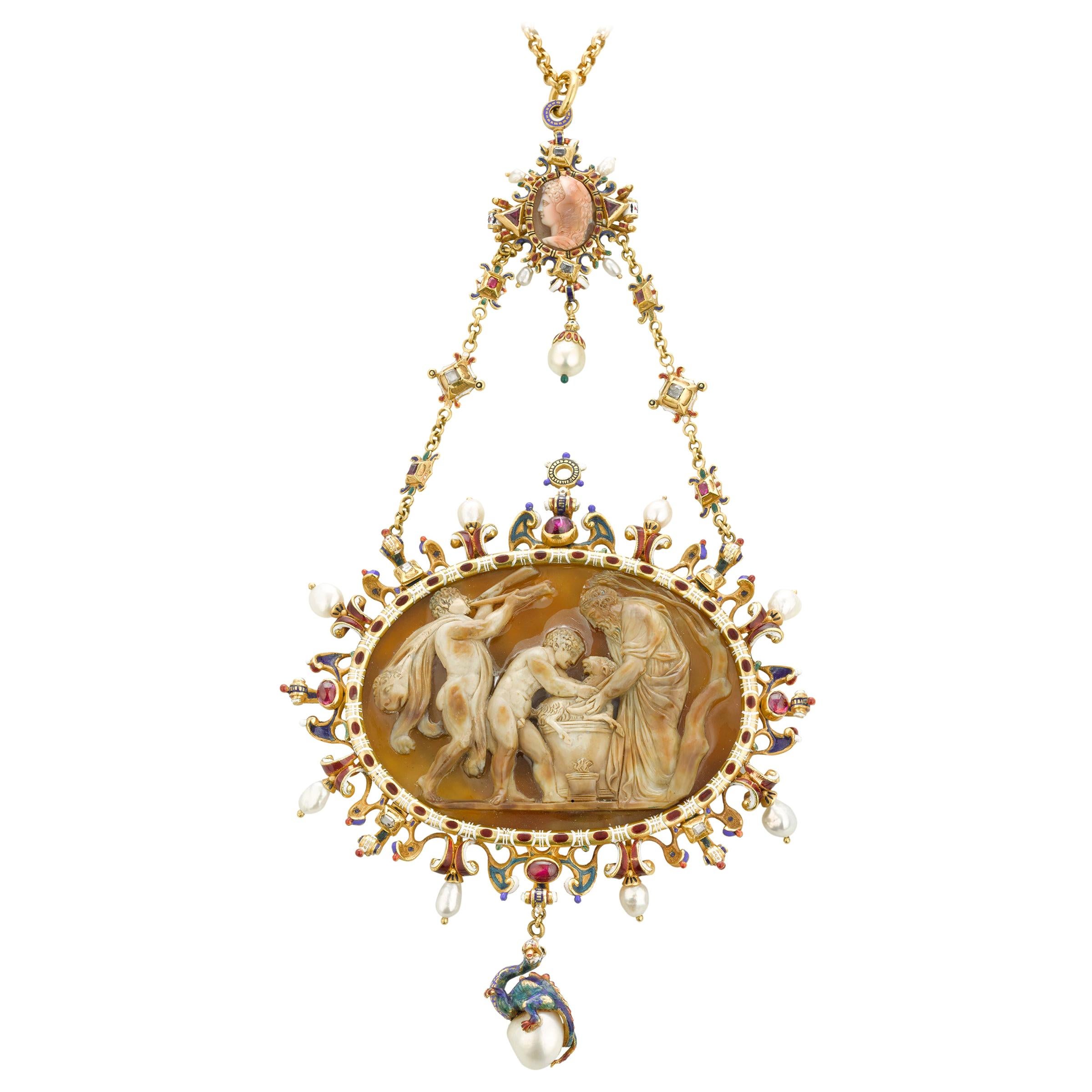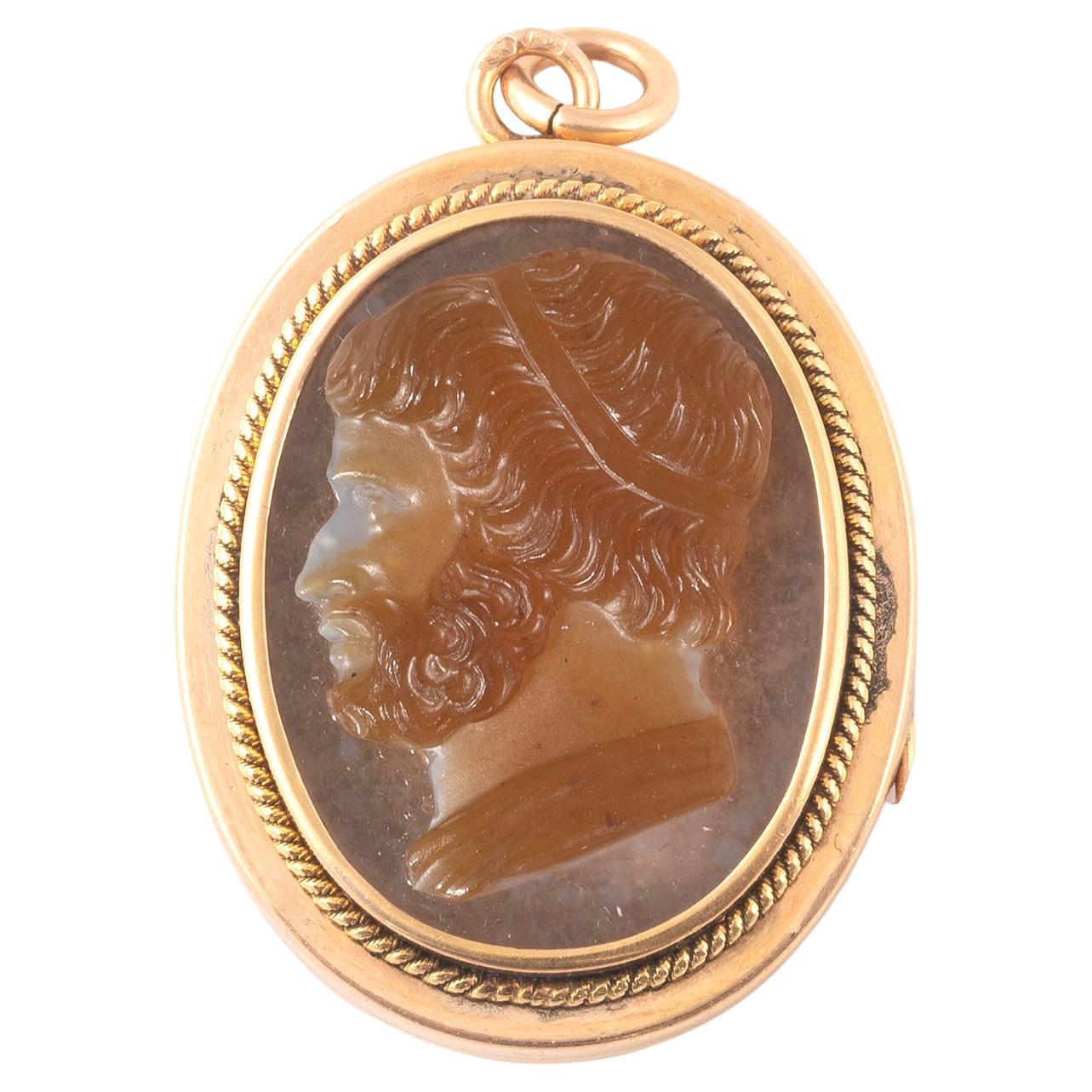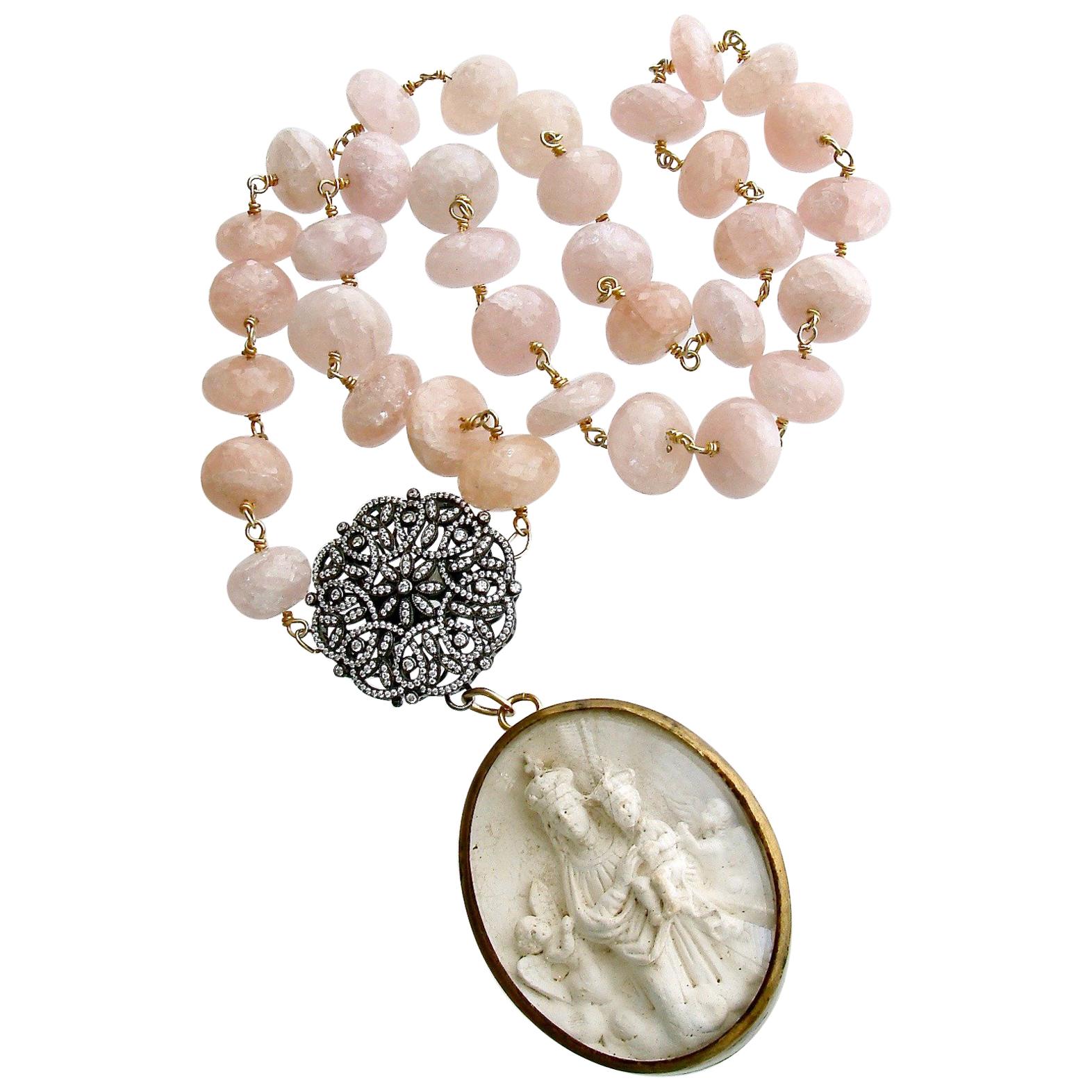Items Similar to Late Renaissance Octagonal Gilded Brass Reliquary Pendant with Velvet Interior
Video Loading
Want more images or videos?
Request additional images or videos from the seller
1 of 8
Late Renaissance Octagonal Gilded Brass Reliquary Pendant with Velvet Interior
About the Item
OCTAGONAL RELIQUARY PENDANT
Probably Italy, c. 1600
Fire-gilded brass, glass, velvet, ink on paper
Weight 63.2 grams; dimensions 82 × 47 × 21 mm (with loop)
Physical description: Double-sided pendant in octagonal form made of fire-gilded brass. Both sides of the pendant with deep profiled frames with glass. The slightly indented side panels comprise openwork friezes with symmetrical scrollwork. On the front is dark red velvet, onto which tiny bone relics of saints (now missing) would have been attached. Labels on a lace-like paper silhouette remain, with names written in ink, mostly faded; only “S. Agnes” is legible. The back is hinged and when opened reveals a velvet-lined interior and paper insert with floral decorations on a turquoise ground, on which fragments of bones are attached. Baluster shaped base for shield-like pendant loop and ring.
This reliquary pendant is difficult to situate historically because it is a composite object. It represents traditional handwork in the form of a paper cutout, combined with a jeweler’s beautiful fire-gilt brass case.
The work of paper cutting, painting, and ornamentation, sometime combined with needlework, is comparable to work still being done in the nineteenth century by nuns and pious ladies. It is prayerful work, a devotional exercise in itself, and shows reverence to the tiny relic fragments that it would have framed and honored. Early versions of this sort of handiwork might be found in the meticulous displays sometimes called “Paradise Gardens.” These were made, beginning in the sixteenth century, by the nuns at Mechelen, in northern Belgium, in multimedia handwork displays of sewing and gluing, combining relics with paper, cloth, glass, metal wire, and found materials. These textured and pious displays were then combined with paintings and cases by professional artists and artisans, as in the example in Cassel.
Unfortunately, because of water damage, only one of the labels of the original relic displayed in this reliquary is legible, inscribed “S. Agnes” at the center top; the other names are faded. Presumably the deep velvet-lined box would have also held an assortment of relics other than the ones that were visible through the glass, and perhaps there would have been another display in the glass on the other side of the pendant.
There is a second paper insert, this one decorated with a turquoise ground and silhouette flowers to which bone fragments seem to be still attached.
The octagonal case, in contrast to the paper cutout, is not at all “home-made.” It has an openwork frieze in scrollwork patterns familiar from enamel work and other metalwork done for European courts and nobility. It is not unlike cases for expensive watches or pendants that were set with jewels. Furthermore, the deeply profiled frames surrounding the glass gives the little piece a substantial presence; even the attachment for the suspension loop is large and assumes a shield-like profile.
There is a latch to open the glass, and presumably the owner often availed herself of her privilege to look inside at her collection of relics after first praying and admiring the handiwork displayed behind the glass.
Comparisons and Literature:
The goldsmith who made this reliquary pendant appears to have adapted his design from an octagonal watchcase from about 1600-20; such cases were often made in gilded brass. A related reliquary pendant in the Bayerisches Nationalmuseum, Munich, in octagonal form made of rock crystal with inserts, was originally intended for relics.
- Metal:
- Weight:63.2 g
- Dimensions:Height: 3.23 in (82 mm)Width: 1.86 in (47 mm)Depth: 0.83 in (21 mm)
- Place of Origin:
- Period:1600-1609
- Date of Manufacture:1600
- Condition:Wear consistent with age and use.
- Seller Location:Chicago, IL
- Reference Number:
About the Seller
5.0
Vetted Seller
These experienced sellers undergo a comprehensive evaluation by our team of in-house experts.
Established in 1991
1stDibs seller since 2021
5 sales on 1stDibs
Typical response time: 16 hours
- ShippingRetrieving quote...Ships From: Chicago, IL
- Return PolicyA return for this item may be initiated within 3 days of delivery.
More From This SellerView All
- Renaissance Reliquary Pendant with Pearl and EnamelingLocated in Chicago, ILRELIQUARY PENDANT WITH PEARL Spain or Spanish Netherlands, c. 1620 Gold, rock crystal, enamel, pearl, bone relics Weight 12.9 grams; dimensions 40 ...Category
Antique 1620s Spanish Renaissance Pendant Necklaces
MaterialsPearl, Gold, Enamel
- Antique Reliquary Book Pendant LocketLocated in Chicago, ILRELIQUARY PENDANT IN BOOK FORM Probably southern Germany, 1630–40 Gilded silver, verre églomisé Weight 13.2 grams; dimensions 42 × 25 × 12 mm; opens to 40 mm Gilded silver pendant in book form with hinged, lid, corded wire surround, and engraved spine. The front cover of the book is set with a plaque depicting Moses receiving the Law in verre églomisé, and the back cover shows the Sacrifice of Abraham. The scenes are in gold against a red background. When opened, the book reveals two portraits, probably of a husband and wife, wearing seventeenth-century dress. The costumes suggest a date c. 1630-40; the wife holds a daisy. Trefoil-shaped pendant loop on top and bottom, and book clasp. As in the scenario described for the assemblage of these pendant miniature books (see no. 34), this book may have satisfied the desires of a particular patron, perhaps even one of the Jewish faith. The images that have been chosen for the four verre églomisé inserts are somewhat unusual within the group of comparable objects; on the front is Moses, on the back is the Sacrifice of Isaac. On the inside, instead of an iconic or doctrinal image, one sees portraits of the patron and his wife, in their finest dress, contents reminiscent of a modern locket...Category
Antique Mid-17th Century Pendant Necklaces
MaterialsGilt Metal
- Fifteenth Century Reliquary Pendant with Christ on the CrossLocated in Chicago, ILReliquary Pendant with Christ on the Cross Germany, c. 1480–1500 Gilded silver Weight 35 grams; dimensions 69 × 46 × 8 mm A mixture of forms gives t...Category
Antique 15th Century and Earlier German Figurines and Sculptures
MaterialsSilver, Gilt Metal
- Antique Spanish Hat Badge Pendant Carved in JetLocated in Chicago, ILBADGE WITH ST. JAMES THE GREAT Northern Spain, 16th century Silver, jet Weight 18.2 grams; dimensions 44 × 43 × 12 mm Round pendant with high-relief image of St. James the Great of Santiago de Compostela carved in jet. The saint is flanked by two pilgrims (their heads defaced); each holds a staff and rosary in his hand. Silver mount with plain flat backplate, corded wire surround and toothed edge as setting. Four pendant loops for sewing onto a hat or cloak. According to the Roman naturalist Pliny, jet, the material of which this pin was made, prevented snakebite and was “thrown up by the sea.” The first quality would certainly have been reassuring for a pilgrim who owned this object and who had to make long journeys over unfamiliar terrain. The second quality made jet an especially fitting material to honor St. James, given that his body arrived in Spain mysteriously, carried there “by the sea” from the Holy Land. Santiago de Compostela was a major center for jet carving from the late Middle Ages, and highly polished jet was a desirable and common material for pilgrimage souvenirs. One even finds scallop shells, the pilgrim’s badge...Category
Antique 16th Century Spanish More Objets d'Art and Vertu
MaterialsSilver
- Antique Spanish Jet Amulet Pendant with FigaLocated in Chicago, ILAMULET PENDANT WITH FIGA Spain, c. 1620–1630 Jet, silver, and enamel Weight 60.7 grams; dimensions 85 × 49 × 18 mm Large pendant in the shape of a hand carved from jet with a clinched fist in the figa (Spanish higa) gesture. In the palm of the hand is a heart carved in relief and on the back a six-ray star in a circle. The silver mount covers the wrist like a cuff and is decorated with a frilled border, and on the front with collet-set bosses with silver C-scrolls against blue enamel; on the back is a roundel in relief with floral motif. Domed base for the pendant loop in pea-pod form. The figa (also fica or higa) represents an age-old symbol of protection against the evil eye and other demonic threats. Its origins were pagan and buried deep in antiquity. Roman examples, such as one found recently in an archeological excavation in London, also make it clear that the protective qualities are based in a sexual symbolism–particularly the power of the phallus. The Roman bone figa/phallus in effect represents the phallus twice; that is, the gesture made by the figa hand is generally explained as fingers representing the female genitalia (vulva) penetrated by the phallus of the thumb. But other interpretations are less specific, including explanations that the left hand is the feminine principle, and the right hand is the masculine. In Spain, jet figa are common; we see one in the portrait of Anne of Austria the infanta (p. 75). That is not to say that the objects are not sumptuous or treasured. Jet was a very valuable material, and in many examples like this one, the figa is embellished with beautiful enameling or is even gem-studded. Comparable objects occur in equally sumptuous materials such as rock crystal. The enameled setting allows a dating of these objects that otherwise might prove difficult, given that the production of such objects in Spain is so consistent over centuries. Indeed, there is another, even more elaborately carved example in this collection, attached to the “magic belt” (no. 9). That example may belong to an earlier group. That figa includes deeply excavated carving, including on the upper surface, an M-shaped design that Walter Leo Hildburgh links to the heart shape (as it occurs more explicitly on this example). Hildburgh argues that its presence is especially common on these objects and that it originally represented the Sacred Heart of Mary...Category
Antique Early 17th Century Spanish Pendant Necklaces
MaterialsSilver
- Antique Gold Pendant with Diamonds and PearlsLocated in Chicago, ILPendant with Virgin Mary as Queen of Heaven Western Europe, Southern Germany (?), Italy (?), c. 1550-1560 Gold, enamel, diamonds, and pearls Weight 13.2 gr; Length 36.9 x 31.2 mm (incl. pearls) This sumptuous image exudes regal power. It portrays the Virgin Mary as Queen of Heaven wearing a dress and crown studded with seven large diamonds and set against a translucent, rich blue celestial background. Far removed from the tender, humble Virgin seen in German and Netherlandish artworks of the period, she is a majestic ruler, mouth sternly set, head tilted upward, and face in full profile. The oval pendant cast in high gold relief with a central medallion, the single figure filling the space, echoes jewelry portraits of the aristocracy during the Renaissance, which similarly offset the ruler’s image against a blue field composed of enamel or lapis lazuli, symbolic of divine power Only the rays of the shining gold halo that emerge behind the Virgin’s head and her long flowing hair (instead of neatly coiffed) distinguish her from female ruler portraits of the period. Three studded pearls, forming an axis, also recall pendants of European rulers. Wealth, royal status, and divine power come together in this opulent pendant. Portraits of the period show similar small oval pendants worn by women in the square of the garment or by men nestled inside multiple chains below the base of the neck. PROVENANCE European Private Collection LITERATURE Compare images from ancient Rome, for example a sardonyx cameo with female head (Kugel 2000, no. 18; Milan, c. 1550), and a pendant with gold, pearls, and enamel in the Staatliche Museum Kassel (Schmidberger/Richter 2001, no. 43; France, c. 1555-1560). For ruler pendants with blue backgrounds see a pendant of King Frances I...Category
Antique 16th Century Pendant Necklaces
MaterialsDiamond, Pearl, Gold
You May Also Like
- Renaissance Cameo PendantLocated in New Orleans, LAThe cameo at the center of this exceptional pendant is a stunning example of the art of gem engraving during the Renaissance. It likely dates to the early 17th century and features a sacrificial scene inspired by the Greco-Roman era. The central flaming altar is flanked by two figures preparing to sacrifice a ram, while a figure in a lion skin blowing horns stands in the left corner. The carver brilliantly uses the natural layers of the stone to achieve the illusion of shadow and musculature on the figures. A second, smaller cameo is set at the top of the pendant, while a myriad of multi-colored gems, pearls and enamel adorns the 18K gold setting. A large Baroque pearl suspended from an enamel dragon finishes the design, which embodies the opulence and theatricality of jewels from the Renaissance age. Cameos and intaglios were highly popular amongst wealthy connoisseurs in Renaissance Italy, and owning the finest pieces was the privilege of princes. Although they were often elaborately mounted for display alone, cameos were also frequently worn as pendants, surrounded by enameled and stone-set gold frames. Such pieces were particularly prized by the Medici and Lorraine families, many of which can now be seen at the National Archeological Museum in Florence. Very few Renaissance cameos...Category
Antique 17th Century Italian Renaissance Pendant Necklaces
MaterialsMulti-gemstone, Pearl, 18k Gold, Enamel
- French Gold-Mounted Pendant Cameo Vinaigrette, Late 18th CenturyLocated in Firenze, ITOval-shaped, the cover set with an agate cameo male portrait bust, the grille a fine floral spray and initial name "B", with suspension ring. 1 in. (25 mm.) long without suspension r...Category
Antique 1790s French Neoclassical Pendant Necklaces
MaterialsAgate, Gold, 18k Gold
- Pink Morganite Filigree Clasp with French Meerschaum Reliquary Ex Voto PendantBy Karen Sugarman DesignsLocated in Colleyville, TXMadonna Necklace. A luxurious strand of hand-linked pink morganite leads the eye to a gorgeous rhodium silver filigree clasp, then drops to feature a ...Category
Antique Mid-19th Century American Artisan Pendant Necklaces
MaterialsMorganite, Topaz, Brass, Vermeil, Rhodium, Sterling Silver
- Vintage Seashell PendantLocated in New York, NYVERY BREEZY presents: This pendant is crafted from a genuine auger seashell, and mounted with a gold-toned metal bail. It was sourced in Italy, and I love to imagine the adventures i...Category
20th Century Italian Pendant Necklaces
- Cynthia Scott 18kt Gold Pendant with an Antique Gaming Counter, Made in ItalyBy Cynthia ScottLocated in Logan, UTAntique Gaming Counters are an incredible artifact of a time and lifestyle in which every detail in life was elevated to the highest luxury. To ...Category
21st Century and Contemporary American Contemporary Pendant Necklaces
Materials18k Gold, Gold
- "CC" Gold Key PendantLocated in New York, NYFigural "key" pendant. The top is comprised of a double "CC" monogram, in textured 14K yellow gold. The key is gilt metal, so you can have your own key custom cut. 1 3/4" x 2/3." ...Category
Vintage 1960s American Pendant Necklaces
MaterialsGold, 14k Gold, Gilt Metal
Recently Viewed
View AllMore Ways To Browse
Hinged Case Watch
Floral Velvet Top
Antique Jewelry Display Cases
Antique Jewelry Display Case
Antique Fire Insert
Antique Fire Inserts
Antique Lace Designs
Antique Pendant Watch Necklace
Antique Watch Pendant Necklaces
Red Velvet Jewelry Box
Glass And Brass Jewelry Box
Antique Velvet Ring Box
Bone Box Brass
Nun Painting
Antique Ladies Watch
Watch Ladies Antique
Antique Ladies Watches
Ladies Antique Watch





